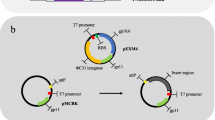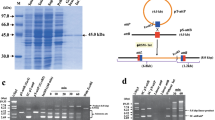Abstract
Phage integrases are enzymes that catalyze unidirectional site-specific recombination between the attachment sites of phage and host bacteria, attP and attB, respectively. We recently developed an in vivo intra-molecular site-specific recombination system based on actinophage TG1 serine-type integrase that efficiently acts between attP and attB on a single plasmid DNA in heterologous Escherichia coli cells. Here, we developed an in vivo inter-molecular site-specific recombination system that efficiently acted between the att site on exogenous non-replicative plasmid DNA and the corresponding att site on endogenous plasmid or genomic DNA in E. coli cells, and the recombination efficiencies increased by a factor of ~101–3 in cells expressing TG1 integrase over those without. Moreover, integration of attB-containing incoming plasmid DNA into attP-inserted E. coli genome was more efficient than that of the reverse substrate configuration. Together with our previous result that purified TG1 integrase functions efficiently without auxiliary host factors in vitro, these in vivo results indicate that TG1 integrase may be able to introduce attB-containing circular DNAs efficiently into attP-inserted genomes of many bacterial species in a site-specific and unidirectional manner. This system thus may be beneficial to genome engineering for a wide variety of bacterial species.



Similar content being viewed by others
References
Bibb LA, Hancox MI, Hatfull GF (2005) Integration and excision by the large serine recombinase ϕRv1 integrase. Mol Microbiol 55:1896–1910
Biswas T, Aihara H, Radman-Livaja M, Filman D, Landy A, Ellenberger T (2005) A structural basis for allosteric control of DNA recombination by λ integrase. Nature 435:1059–1066
Campbell A (1962) Episomes. Adv Genet 11:101–145
Campbell A (1992) Chromosomal insertion site for phages and plasmids. J Bacteriol 174:7495–7499
Foor F, Roberts GP, Morin N, Snyder L, Hwang M, Gibbons PH, Paradiso MJ, Stotish RL, Ruby CL, Wolanski B, Streicher SL (1985) Isolation and characterization of the Streptomyces cattleya temperate phage TG1. Gene 39:11–16
Ghosh P, Kim AI, Hatfull GF (2003) The orientation of mycobacteriophage Bxb1 integration is solely dependent on the central dinucleotide of attP and attB. Mol Cell 12:1101–1111
Goryshin IY, Jendrisak J, Hoffman LM, Meis R, Reznikoff WS (2000) Insertional transposon mutagenesis by electroporation of released Tn5 transposition complexes. Nat Biotechnol 18:97–100
Gregory MA, Till R, Smith MCM (2003) Integration site for Streptomyces phage ϕBT1 and development of site-specific integrating vectors. J Bacteriol 185:5320–5323
Groth AC, Calos MP (2004) Phage integrases: biology and applications. J Mol Biol 335:667–678
Groth AC, Olivares EC, Thyagarajan B, Calos MP (2000) A phage integrase directs efficient site-specific integration in human cells. Proc Natl Acad Sci USA 97:5995–6000
Ikeda H, Ishikawa J, Hanamoto A, Shinose M, Kikuchi H, Shiba T, Sakaki Y, Hattori M, Omura S (2003) Complete genome sequence and comparative analysis of the industrial microorganism Streptomyces avermitilis. Nat Biotechnol 21:526–531
Landy A (1989) Dynamic, structural, and regulatory aspects of lambda site-specific recombination. Annu Rev Biochem 58:913–949
Li W, Kamtekar S, Xiong Y, Sarkis GJ, Grindley NDF, Steitz TA (2005) Structure of a synaptic γδ resolvase tetramer covalently linked to two cleaved DNAs. Science 309:1210–1215
Matsuura M, Noguchi T, Yamaguchi D, Aida T, Asayama M, Takahashi H, Shirai M (1996) The sre gene (ORF469) encodes a site-specific recombinase responsible for integration of the R4 phage genome. J Bacteriol 178:3374–3376
Morita K, Yamamoto T, Fusada N, Komatsu M, Ikeda H, Hirano N, Takahashi H (2009a) In vitro characterization of the site-specific recombination system based on actinophage TG1 integrase. Mol Genet Genomics 282:607–616
Morita K, Yamamoto T, Fusada N, Komatsu M, Ikeda H, Hirano N, Takahashi H (2009b) The site-specific recombination system of actinophage TG1. FEMS Microbiol Lett 297:234–240
Olivares EC, Hollis RP, Calos MP (2001) Phage R4 integrase mediates site-specific integration in human cells. Gene 278:167–176
Rashel M, Uchiyama J, Ujihara T, Takemura I, Hoshiba H, Matsuzaki S (2008) A novel site-specific recombination system derived from bacteriophage ϕMR11. Biochem Biophys Res Commun 368:192–198
Russell JP, Chang DW, Tretiakova A, Padidam M (2006) Phage Bxb1 integrase mediates highly efficient site-specific recombination in mammalian cells. Biotechniques 40:460–464
Smith MCM, Thorpe HM (2002) Diversity in the serine recombinases. Mol Microbiol 44:299–307
Stoll SM, Ginsburg DS, Calos MP (2002) Phage TP901-1 site-specific integrase functions in human cells. J Bacteriol 184:3657–3663
Thorpe HM, Smith MCM (1998) In vitro site-specific integration of bacteriophage DNA catalyzed by a recombinase of the resolvase/invertase family. Proc Natl Acad Sci USA 95:5505–5510
Thyagarajan B, Olivares EC, Hollis RP, Ginsburg DS, Calos MP (2001) Site-specific genomic integration in mammalian cells mediated by phage ϕC31 integrase. Mol Cell Biol 21:3926–3934
Xu Z, Lee NCO, Dafhnis-Calas F, Malla S, Smith MCM, Brown WRA (2008) Site-specific recombination in Schizosaccharomyces pombe and systematic assembly of a 400 kb transgene array in mammalian cells using the integrase of Streptomyces phage ϕBT1. Nucleic Acids Res 36:e9
Acknowledgments
We thank S. Nonoda for technical support. This work is supported in part by a Grant-in-Aid for Young Scientists (B) No. 10017551, and a grant to promote advanced scientific research, and Matching Fund Subsidy for Private Universities from the Ministry of Education, Culture, Sports, Science and Technology of Japan, and a Research Grant of College of Engineering, Nihon University for 2010.
Author information
Authors and Affiliations
Corresponding author
Additional information
Authors Nobutaka Hirano and Tetsurou Muroi contributed equally to this work and should be regarded as joint first authors.
Electronic supplementary material
Below is the link to the electronic supplementary material.
ESM 1
(DOC 31 kb)
Rights and permissions
About this article
Cite this article
Hirano, N., Muroi, T., Kihara, Y. et al. Site-specific recombination system based on actinophage TG1 integrase for gene integration into bacterial genomes. Appl Microbiol Biotechnol 89, 1877–1884 (2011). https://doi.org/10.1007/s00253-010-3003-7
Received:
Revised:
Accepted:
Published:
Issue Date:
DOI: https://doi.org/10.1007/s00253-010-3003-7




